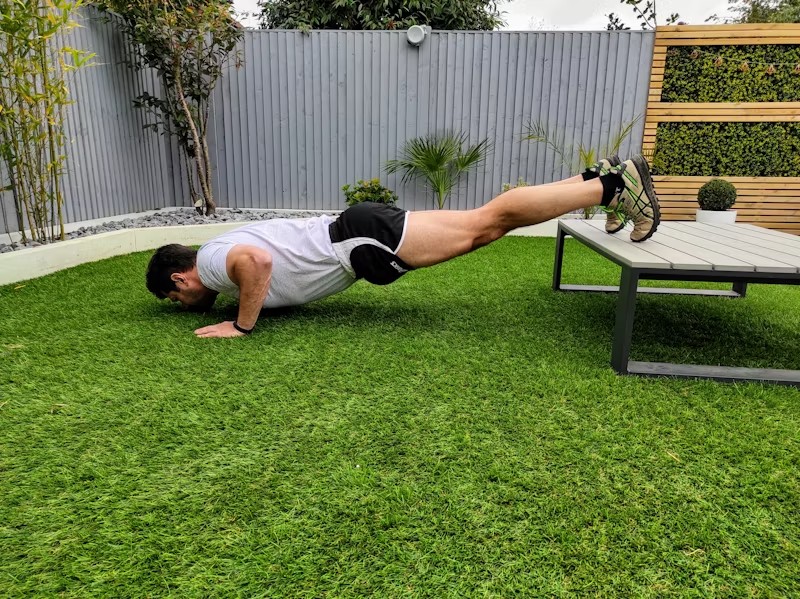
Push-ups are a versatile and effective bodyweight exercise that offer numerous health benefits. Here are some key advantages of incorporating push-ups into your fitness routine:
1. Strengthens Multiple Muscle Groups
Push-ups engage various muscles simultaneously, including the chest (pectoralis major and minor), shoulders (deltoids), arms (triceps and biceps), and core muscles. This compound movement enhances upper body strength and contributes to overall muscle development.
2. Improves Cardiovascular Health
When performed in higher repetitions or as part of a circuit, push-ups can elevate your heart rate, providing cardiovascular benefits. This increased heart activity strengthens the heart muscle, enhances circulation, and promotes better heart function.
3. Enhances Core Stability and Posture
Maintaining proper form during push-ups requires engaging the core muscles, which stabilizes the spine and promotes better posture. Strengthening these muscles can reduce the risk of back pain and improve functional fitness for daily activities.
4. Supports Joint and Bone Health
Regularly performing push-ups helps strengthen the muscles surrounding the shoulder and elbow joints, providing better support and reducing injury risk. Additionally, as a weight-bearing exercise, push-ups can contribute to increased bone density, supporting overall bone health.
5. Aids in Weight Management
Incorporating push-ups into your exercise regimen can help burn calories and build lean muscle mass, which in turn boosts metabolism. This combination is beneficial for weight management and improving body composition.
6. Enhances Functional Strength
The strength gained from push-ups translates into improved performance in everyday tasks that require pushing, lifting, or carrying objects. This functional fitness aspect makes daily activities easier and reduces the risk of injuries.
7. Convenient and Adaptable Exercise
Push-ups require no equipment and can be performed anywhere, making them a convenient addition to any workout routine. They can also be modified to suit different fitness levels, such as performing knee push-ups for beginners or incorporating variations like diamond push-ups for added challenge.
Incorporating push-ups into your regular exercise routine can lead to significant improvements in strength, endurance, and overall health. As with any exercise, it’s important to use proper form and gradually increase intensity to prevent injury and achieve optimal results.
How beginners can start doing pushup exercise
Starting a push-up routine as a beginner can be challenging, but with a structured approach, you can build strength and progress safely. Here’s a step-by-step guide to help you begin:
1. Wall Push-Ups
Begin with wall push-ups to familiarize yourself with the movement while minimizing strain:
Stand facing a wall, about arm’s length away.
Place your palms on the wall at shoulder height and shoulder-width apart.
Bend your elbows to slowly bring your chest toward the wall.
Push back to the starting position.
This variation reduces the amount of body weight you need to lift, making it an excellent starting point.
2. Incline Push-Ups
Once comfortable with wall push-ups, progress to incline push-ups:
Use a sturdy elevated surface like a bench or table.
Place your hands on the edge, slightly wider than shoulder-width.
Step your feet back, keeping your body straight.
Lower your chest toward the edge, then push back up.
The higher the surface, the easier the exercise; gradually decrease the height as you gain strength.
3. Knee Push-Ups
After mastering incline push-ups, move to knee push-ups:
Start in a plank position with your knees on the ground.
Hands should be shoulder-width apart.
Lower your chest toward the floor while keeping your body straight from head to knees.
Push back up to the starting position.
This variation increases the load on your upper body while still providing support.
4. Negative Push-Ups
To build strength for standard push-ups, incorporate negative push-ups:
Start in a high plank position.
Slowly lower yourself to the ground over a count of several seconds.
Reset and repeat without pushing back up.
Focusing on the lowering phase helps develop the necessary muscle strength.
5. Standard Push-Ups
Once you’ve built sufficient strength, attempt standard push-ups:
Begin in a high plank with hands shoulder-width apart.
Keep your body in a straight line from head to heels.
Lower your chest to the floor by bending your elbows.
Push through your palms to return to the starting position.
Tips for Success:
Maintain Proper Form: Keep your core engaged and body aligned to prevent injury.
Gradual Progression: Only move to the next variation when you can perform the current one with ease.
Consistency: Aim for regular practice, gradually increasing repetitions and sets.
Rest and Recovery: Allow your muscles time to recover between workouts.
By following this progression and listening to your body, you’ll develop the strength and confidence to perform push-ups effectively.
